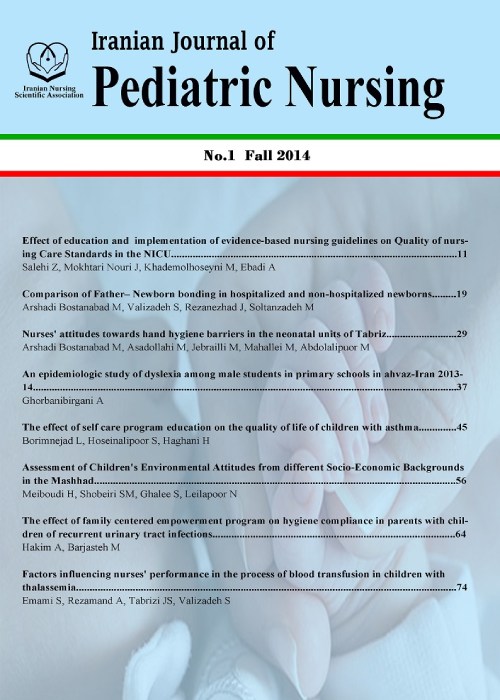Evaluation of self-report of the medication errors and its barriers in pediatric wards
Abstract:
Introduction
Medication is considered as one of the most common and critical tasks for nurses. Identifying the rate and barriers of self-reporting the medication errors is essential to maintain patient safety and improve the quality of nursing care. The aim of this study was to evaluate the self-report of the medication errors in the pediatric wards and its barriers from a nursing viewpoint.Methods
In this cross-sectional and correlational study, 148 nurses of Bahrami children's hospitals and Children's Medical Center affiliated to Tehran University of Medical Sciences were selected using the census method in 2015. Data were collected by a researcher-made questionnaire including demographic information, the incidence of medication errors and barriers to underreporting of medication errors. To ensure the reliability of questionnaire, calculating Cronbach's Alpha Coefficient for Internal Consistency was used. The data were analyzed by SPSS version 16.Results
112 (76%) the nurses have been committed medication errors during their last year of work and Only 28% of the them had self-reported medication errors. 88% of nurses have experienced barriers to self-reporting medication errors and the incidence of medication errors (injectable and non-injectable) was 89%. The most common errors were associated with using abbreviated names of drugs and the nominal similarities of some drugs with some other. The most common barriers to reporting of medication errors were associated with nurse's fear of the effect of the errors on serious harm to the patients, blood money payment, and impact on annual evaluation after reporting. The logistic regression model showed no significant relationships between the incidence of the medication errors with the nurse's sex (p=0.19), age (p=0.065), job experience (p=1.21), employment status (p=0.81) and education (p=0.59) and showed a significant relationships between shifts and the incidence of the medication errors (p =0.004).Conclusion
Given that the majority of medication errors were not reported by the nurses, it is needed to create necessary settings to facilitate and increase reporting the medication errors by them. Creating a positive relationship between the managers and the nurses and providing the appropriate atmosphere at the time of reporting is suggested.Keywords:
Language:
Persian
Published:
Iranian Journal of Pediatric Nursing, Volume:3 Issue: 1, 2016
Pages:
71 to 80
magiran.com/p1598599
دانلود و مطالعه متن این مقاله با یکی از روشهای زیر امکان پذیر است:
اشتراک شخصی
با عضویت و پرداخت آنلاین حق اشتراک یکساله به مبلغ 1,390,000ريال میتوانید 70 عنوان مطلب دانلود کنید!
اشتراک سازمانی
به کتابخانه دانشگاه یا محل کار خود پیشنهاد کنید تا اشتراک سازمانی این پایگاه را برای دسترسی نامحدود همه کاربران به متن مطالب تهیه نمایند!
توجه!
- حق عضویت دریافتی صرف حمایت از نشریات عضو و نگهداری، تکمیل و توسعه مگیران میشود.
- پرداخت حق اشتراک و دانلود مقالات اجازه بازنشر آن در سایر رسانههای چاپی و دیجیتال را به کاربر نمیدهد.
In order to view content subscription is required
Personal subscription
Subscribe magiran.com for 70 € euros via PayPal and download 70 articles during a year.
Organization subscription
Please contact us to subscribe your university or library for unlimited access!



